#phylloxyron
Explore tagged Tumblr posts
Photo

Based on specimens previously identified as Tropidostoma, a new taxon of dicynodont (Bulbasaurus phylloxyron gen. et sp. nov.) from the Karoo Basin of South Africa is described.
(Kammerer & Smith, 2017)
Submitter comment: “ I see what you did there[.]”
Also the species name translates to “leaf razor”! While the paper doesn’t spell out the Pokémon connection, the first author is on record saying, “similarities between this species and certain other squat, tusked quadrupeds may not be entirely coincidental.” And in a series of now deleted tweets, he said “OR WAS IT?” in response to “It was not named after the Pokemon.” and “Also, did you note the species name?” in response to “No, not named after the #pokemon Bulbasaur!”—Ed.
669 notes
·
View notes
Text
Bulbasaurus phylloxyron looked like this btw

(source)
61 notes
·
View notes
Text
I'm new to this Tumblr thing, but I seem people sharing their writing here. So I decided to share this short story I wrote about a zookeeper in a prehistoric creature zoo dealing with feisty bulbasaurus.

Also made this sketch based on a part of the story, because I'm pretty sure most people aren't familiar with the genus bulbasaurus phylloxyron. It's not very accurate to how the animal probably was when he was alive, but it's just so the reader can have something in mind as they read the story.
Anyway, here's the story:
“Well, I'm not doing that.” said Alex, looking at the task board in the break room.
“Me neither.” responded Marie, turning a cup of joe at the coffee table a few feet away from him.
“Oh come on, I already have to clean 2 other enclosures today!” whined Alex letting his head fall to his back.
Marie finished her coffee and paused a little before responding “And?”
“I'm going to be so tired after them, I'm not going to be able to deal with those guys.” he said, turning to look at her, but she didn't look back.
“I'm already tired, find someone else.” she responded quickly already knowing where he was going.
“Who's gonna be oblivious enough to accept?” Alex said, turning back to the task board.
Tyler, who was 5 minutes late to his shift, entered the break room soaked in rain. The young man forgot his umbrella and was hanging his wet hoodie on the coat hanger, before noticing Alex looking at him with a seemingly innocent smile.
Tyler was now in the bulbasaurus enclosure, it was a thick fern prairie with some tall rocks for them to climb on here and there so guests could see them, it also had a shaded feeding area that he was using to shelter from the rain that was built into the one meter tall stone wall that surrounded the enclosure. What Alex hadn't told him, the bulbasaurus were currently very territorial. As Tyler cleaned the food tray, a male charged at him, it shook its head from side to side and snorted as it looked down at him, it had claimed the area as his territory and wasn't satisfied with Tyler on it. The young man groaned, and while on the ground, picked up the shovel next him and pushed the critter away. He sat up, and to avoid getting hit by the angry bulbasaurus, he put the food tray in between them, so when the bulbasaurus charged at him again it would hit the tray instead of his legs.
After he finished scrubbing the foul smell of Bulbasaur saliva off of the food tray's metal, he stood up pressing the shovel against the male's head, because it was still not very happy with Tyler's presence. The rain had stopped and now he could begin cleaning off what happened after the critters finished eating and digesting their food. He took one step into the fern prairie and he already knew what the struggle would be. He slowly pulled his foot out of the ground to see the sole of his boots were now stained with Bulbasaur shit, the worst part was he could barely tell where it was, due to the the fern leaf's being so broad that the whole ground was obscured by them. And to make things worse, while his feet was up another male charged at him, and he could only hear the rustling of the prairie as it scurried away while he laid with his face on the dirt.
As he was cleaning himself off with the water from his bottle, He thought of a strategy to let him pick up all the dung off the floor without getting charged at or dirty. Before he took the first step back into the prairie, he used his shovel to slowly pat and feel the ground under the ferns. The ground seemed flat and firm so he took a step. He repeated this for every step he took, until he was near a small rock, where he had felt something soft, so he picked it up with the shovel and as expected, it was poop. He put it inside a large green bag he carried on his left hand and began walking towards a taller rock; after confirmation that technique worked, he began taking more confident steps. As he was getting closer, he felt the same softness from before, but before he could pick anything up, he heard the rustling of ferns coming from behind him. He quickly turned and put the shovel on the ground, pointing it to the direction the sound was coming from, in a flash he looked down to see the rustling getting closer until it stopped at the shovel and made a loud clank. The sound that Tyler now recognized as a distressed Bulbasaur came from under the ferns, he watched the rustling of it walking away before turning back to pick up another turd.
While he was halfway checking the whole enclosure for poop, he felt his shovel touch something different, it was firm but clearly not stuck to the ground, and after he stopped pressing it, it began rolling. That was followed by a high pitched ‘growl’ and a tug in the shovel, Tyler lifted it up to see a female bulbasaurus using all her bite strength to bite the shovel, he laid her back on the ground carefully. He had found the reason why males were so territorial, he picked up what had rolled off to check it out. It was a round soft ball, probably filled with some liquid, meant to resemble an egg. Due to the zoo not breeding animals, during mating season, the zoo would give the couples fake eggs to disincentivize females to lay new eggs. He gave the “egg” back to the female and continued in a different direction.
As tyler picked up the last turd and was done checking the whole 500 square meters enclosure, he put it inside the green bag and wrapped it up. And as he was walking out, through a backdoor in the feeding area, he felt a tug on the green bag. He turned back to see the male that claimed the feeding area as his territory, biting and trying to pull the back. He quickly pushed him away with the shovel away with a shovel and, but he had left some cuts on the bottom of the bag. Tyler quickly turned the bag upside down and held it with both his arms to prevent any leaking. He cussed the male Bulbasaur as he left the enclosure, having to smell everything inside the bag until he made his way to waste management.
After leaving waste management, Tyler went straight to the break room for a quick rest. In the break room, alex was lazing on the coffee table, Tyler sat across from him, crossing his arms over the table and laying his head on them.
“So how was it?” Alex asked with a non genuine innocent voice.
Tyler just sat there looking into nowhere
“As I imagined” Alex responded letting out a sensible chuckle.
4 notes
·
View notes
Text

Bulbasaurus phylloxyron, honorary reptile. i started this blog so i had something to do if i didnt have anything else i wanted to draw that day or as a warmup so im going to try and let myself do whatever each day instead of rendered speedpaints :)
249 notes
·
View notes
Text
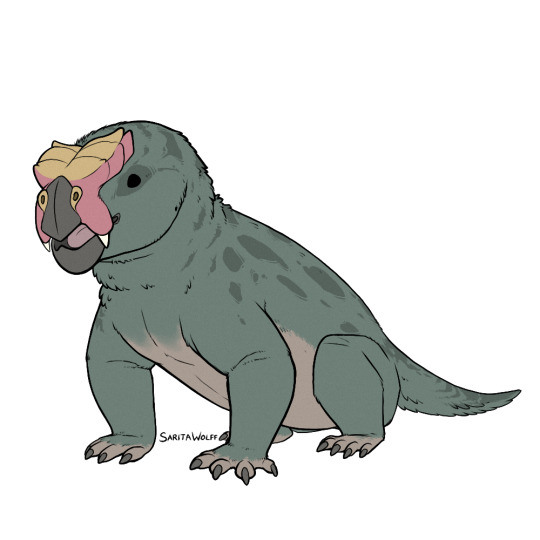
I wanted to do one more dicynodont to show just how diverse these guys were. Yes I could have done Diictodon... but instead I chose Bulbasaurus phylloxyron. Did I choose it just for that name? Maybe.
Apparently, Bulbasaurus was not originally named after the Pokémon bulbasaur, but rather for the “bulbous” headgear on its nose. However, its describers have admitted that its name and similarity to the Pokémon “may not be entirely coincidental.”
Also, “phylloxyron” means Razor Leaf. Apparently also maybe possibly a coincidence as it relates to its leaf-cutting beak. But I think we all know paleontologists are a bunch of nerds, so...
23 notes
·
View notes
Note
There’s a dinosaur named Sauron, a Dicynodont named Bulbasaurus phylloxyron (leaf razor), a Pterosaur named Aerodactyl, an Ankylosaur named Zuul, a Trilobite named Han solo, an extinct Sea Cucumber named Cthulhu.
Exhibit A (This is relevant and very important to the ask)
Exhibit B (supports Exhibit A)
18 notes
·
View notes
Text
Remember that there was a Dicynadont discovered 2 years ago called Bulbasaurus, and the specific name of the type species (Phylloxyron) means "leaf razor" and yet the scientists said it's not entirely coincidental 🍃

2K notes
·
View notes
Photo

Who’s that synapsid?
It’s Bulbasaurus phylloxyron!
This creature was a member of the dicynodonts, a group of herbivorous mammal-relatives with beaks and protruding tusks. Its fossils are known from the Late Permian of South Africa, about 259-254 million years ago, and it would have been roughly the size of a cat, around 60cm long (2′).
It wasn’t officially named after the pokémon character Bulbasaur, but instead in reference to the bulbous bosses on its snout. But combined with how the species name “phylloxyron” means “leaf razor”, it doesn’t seem to entirely be a coincidence.
#science illustration#paleontology#paleoart#palaeoblr#bulbasaurus#geikiidae#dicynodont#anomodontia#therapsid#synapsid#stem-mammals#art#pokemon#stop shrink-wrapping synapsids#speculative fluffiness#why even be so coy about the name origin though?#we already have Aerodactylus and that one was outright stated to be named after a pokémon
2K notes
·
View notes
Text
Pokemon Re-Typed: Bulbasaur Line

The original grass starter - Bulbasaur and its evolutions are also, like most of the Gen I grass types, half poison. Conceptually, the whole line has sort of looked a bit frog-like to me, especially those ‘ears’, the lack of a tail and Venusaur, in particular, has all these wart-like bumps.
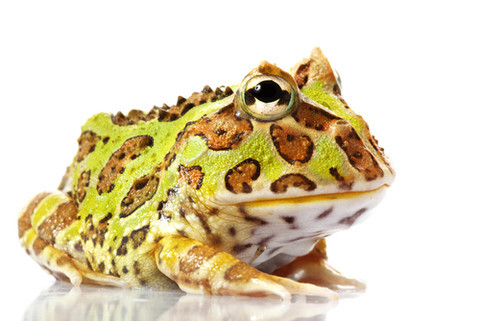
And for their type I got...

So, I gotta be honest, before I even got to the ‘maybe I could blog this’ stage I had tried out generating a type for Bulbasaur just for fun. So I have had a bit more time to think of this then I probably will going forward.
Anyway - my initial gut thought was of succulent rock plants - succulents are a pretty common sight and topic of conversation in the Western Cape of South Africa where I live

However, I began to feel like such an addition would better benefit a Rock-type form of Bulbasaur. I drifted on to deserts, which in many Pokemon games are the main location for ground types, and thinking of plants in deserts one immediately thinks of cacti.
However, I didn’t really like this idea. Cacti still seem like more grass type than ground type to me. Even the actual cactus Pokemon, Cacnea, and Maractus are pure grass types. So I thought of the other main location in the games you find Ground type Pokemon - caves.
Plants don’t exactly thrive in caves, so I began to think about what a Bulbasaur without its bulb would look like. After all, their Pokedex entries normally make it seem like the plant is attached to Bulbasaur after it is born (I know all Pokemon are hatched from eggs in their basic or baby stage practically identical to the others of their kind, but I view that as a mechanic rather than a representation of reality). So, what if in some region a group of the Bulbasaur-line adapted to a life in caves, giving up their symbiotic relationship to plants altogether.
While I do think Bulbasaur are frog-like, the ‘saur’ part of their name and certain features also call to mind some of the so-called ‘mammal-like reptiles or ‘Therapsids’. Indeed, recently there even was a Dicynodont discovered that was named Bulbasaurus.
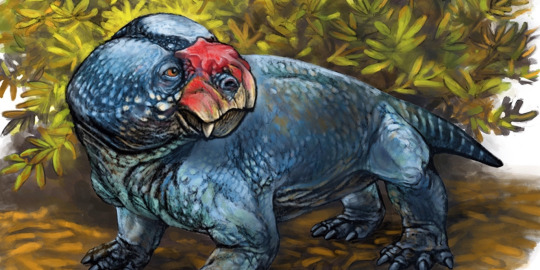
Having worked in the Natural history museum recently where its skull was on display, I am aware that there is some vehement denial that it was named after a cartoon monster and instead named for its bulbous nose. Still, I remain aware that there is a trilobite called Han solo and that this particular species was called Bulbasaurus phylloxyron with phylloxyron meaning ‘leaf razor‘ WHICH TOTALLY DOES NOT REMIND ME OF ANYTHING ELSE...
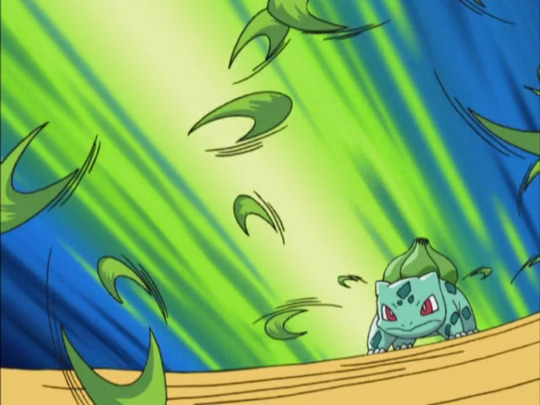
Anyway, why I bring this up is because certain Dicynodonts were burrowing animals. Bulbasaur and its line certainly do bear some resemblance to Dicynodonts - especially looking at Ivysaur’s projecting teeth and the beak-like shape of Bulbasaur and Ivysaurs mouth.
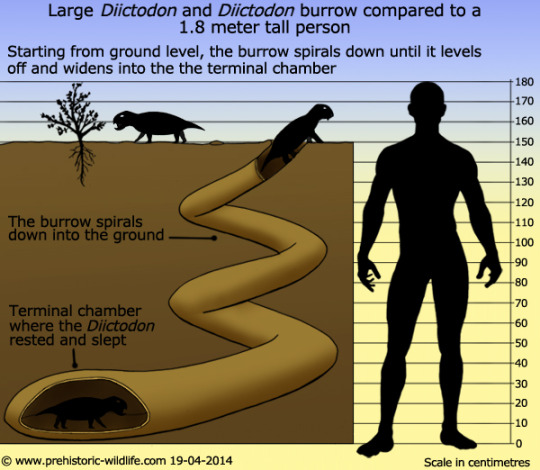
So, Subterranean form Bulbasaur is a pure ground type - they never bond with a plant and, lacking the defensive poisons and abilities of this plant, become timider, nocturnal creatures that hide in burrows or caves during the day, emerging at night to forage.
While I considered Bulbasaur growing large front teeth like Ivysaurs to resemble the burrowing teeth of a mole-rat...
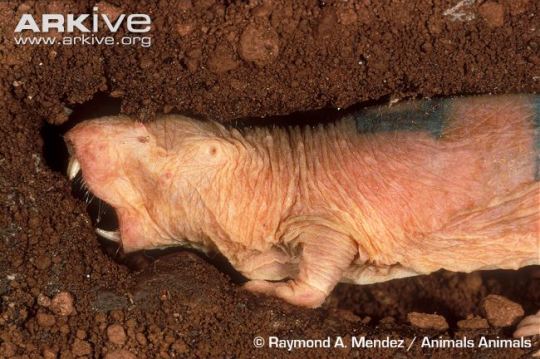
... Ultimately I decided that subterranean form Bulbasaur is mostly unchanged. it lacks a plant on its back, having instead a flat back making its overall posture lower to the ground. Its front legs are slightly larger than a normal Bulbasaur’s, with more noticeable claws, to help it dig. Its color is duller than regular Bulbasaur - moving towards a paler skin. Its eyes are smaller as well, but to compensate its nose has become swollen like Bulbasaurus to sniff out food at night and underground.
For subterranean form Ivysaur, I thought of another Therapsid group - Gorgonopsia
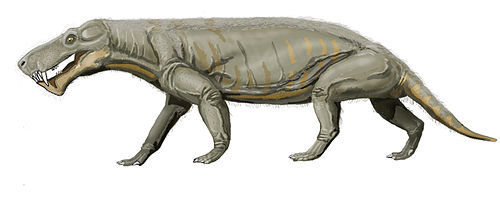
Ivysaur already has those projecting teeth. Subterranean Ivysaur has longer teeth. Still pure ground type, these Ivysaur have become purely cave-dwellers. Their eyes have shrunk to almost nothingness, but their nostril bulb has become even larger. Subterranean Ivysaur, without a plant on its back, still has a flat-profile but also has longer, straighter-legs. It’s a fast hunter that chases prey through the dark caverns beneath the world in packs. Its pigment has almost entirely faded, leaving it a dull gray in color.
When subterranean Ivysaur become Venusaur, they become quite the opposite to agile hunters and become massive ambush predators - again with Venusaur being the most frog-like of the group although in this case, I’m thinking of a particular one

I imagine subterranean Venusaur being like a cave-dwelling Suriname Toad. Its eyes have completely vanished, and its head it little more than a massive mouth and nostrils. Subterranean Venusaur buries itself in the sand of the cave floor with only its swollen nostrils projecting. When it smells prey, it lunges forward suddenly and engulfs it in its huge mouth. Although definitely the largest and heaviest of its line, it would also be extremely flat to hunt this way. At this point, its pigment, like its eyes, is completely gone leaving it a ghostly white like most cave-dwellers
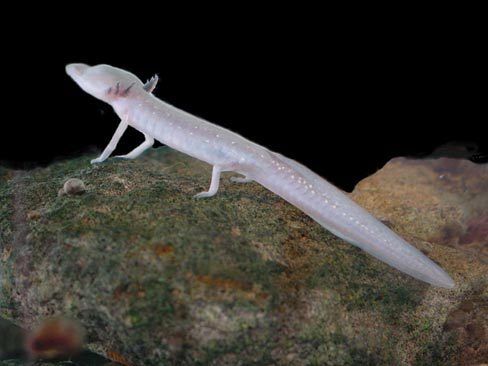
But, what about Mega Venusaur?
Well, Trypophobes may want to look away for this bit, but seeing as I did mostly base subterranean Venusaur off of a Suriname toad, there is a particular thing that toad is famous for besides its flatness...

Suriname toad eggs are embedded on the female’s back by the male. Over time, the eggs sink into the skin on the toad’s back - where they develop and eventually hatch as tiny toadlets. There’s a lot of videos on this if you’re curious :).
For Mega Venusaur, however, this process has nothing to do with reproduction. Rather, when exposed to its mega-stone, a part of subterranean Venusaur ‘remembers’ its ancestral practice of carrying a flower on its back. On the skin on its back erupts into hundreds of ghostly, luminescent plant tendrils - literal ‘ghosts’ of the plants that could have been

At this point, Mega Venusaur gains the Ghost type - becoming a ground/ghost Pokemon as long as it is Mega evolved.
In general, I like the idea of these alternate form megas not quite working as the mega-stone is meant to work with their ‘original’ form, but we’ll see as we go on...
I’m not too knowledgeable on balancing or changing stats and abilities in Pokemon, but to give a general idea: all the subterranean Bulbasaur forms will no longer learn grass or poison moves - instead learning ground and probably rock type moves. They would lose OVergrowth/Chlorophyll and gain something like Sand Veil. I wish Illuminate was a better ability as it would be perfect for Mega Venusaur’s ghostly plants - perhaps some version of that ability that had an effect. Stats wise, I can’t see these Pokemon being too different - perhaps physically tougher with higher ATK and DEF and lower SP. ATK and Sp. DEF and subterranean Ivysaur probably would be faster than regular Ivysaur.
Which brings us to the end of my first post in this series. I hope it was at least entertaining and, if somehow, this inspires you to try to draw what these subterranean forms would look like, I would love to see what you come up with.
Otherwise, check-in hopefully this time tomorrow and I'll move on to the next evolutionary line - Charmander's
#pokemon#bulbasaur#ivysaur#venusaur#pokemon re-typed#bulbasaurus#gorgonopsid#suriname toad#ghost flower
5 notes
·
View notes
Link
Animals from this period were bizarre experimentations, with early ancestors evolving for some of the well-known groups still around today, like crocodiles, turtles and mammals.
Some of these include the dicynodonts, who despite looking more 'reptilian', are actually the precursors of early mammals. They were pretty weird looking, like a cross between a turtle and a wild boar.
Dicynodonts, mammals and all other animals more closely related to mammals than any other egg-laying animals are called 'synapsids', and a pretty important group. Even humans are synapsids, so dicynodonts are like our great, great, great (etc.) grand-cousins.
A new species of dicynodont has been described from the Karoo Basin of South Africa, which researchers have dubbed Bulbasaurus phylloxyron. Pokémon fans around the world rejoice! ...
#bulbasaur#dincynodont#cynodont#therapsid#mammal like reptile#animals#nature#science#illustration#pokemon#synapsid#prehistoric#africa
218 notes
·
View notes
Note
Learning there's a synapsid named Bulbasaurus phylloxyron changed my life, it's my favorite synapsid now (plus it's cute)
Bulbasaurus truly is the best boy

(by Christopher DiPiazza)
83 notes
·
View notes
Note
Had you heard that scientists named a prehistoric animal after Bulbasaur (Bulbasaurus phylloxyron, a dicynodont- it actually does looks sort of like Bulbasaur sans the plant on its back, honestly)? I know it's not really your forte, but you do like some Bulbasaur, so I figured there was a 50/50 chance you'd be interested. I know I'm partying that my favorite Pokemon got the nod!
WOOT! All hail Bulbasaur! =D
61 notes
·
View notes
Photo
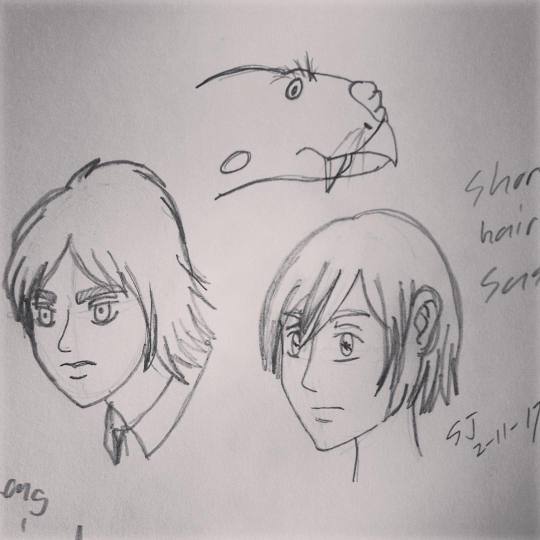
I doodled/sketched these two characters (from left to right) and a dicynodont (above) which was included Bulbasaurus phylloxyron (named after bizarre bulbous nose, but not directly named after the Pokémon Bulbasaur, but still homage to discovery.) and the bottom there was long-haired Eren Yeager and short-haired Sasha braus from Attack on Titan/Shingeki no Kyojin chapter 90, which is surprising they're hair has sudden changed. #erenyaeger #sashablouse #sashabraus #erenjaeger #bulbasaurus #dicynodont #synapsid #eresasha #snkspoilers #chapter90 #longhair #shorthair #sketch #doodles #sketchbook #manga
#chapter90#longhair#dicynodont#sashabraus#erenjaeger#eresasha#snkspoilers#manga#synapsid#shorthair#sketch#erenyaeger#doodles#sashablouse#bulbasaurus#sketchbook
0 notes
Photo

Photograph and diagram of holotype skull Bulbasaurus phylloxyron

Evolution of Bulbasaur design.
Pick your favorite
39K notes
·
View notes